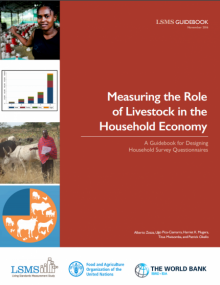
This Guidebook presents a module template for effectively including livestock in multi-topic and agricultural household surveys in low- and middle-income countries. It is a practical tool for survey practitioners—including Bureaus of Statistics, ministries responsible for livestock, and non-governmental and civil-society organizations, regional institutions, international organizations, the private sector, and other stakeholders—to collect data on the role of livestock in the household economy and its contribution to livelihoods. The data will assist in generating statistics on key features of the smallholder livestock sector—from herd size and composition to husbandry and production practices, from meat, milk, and egg production to livestock income. These statistics represent the backbone for effective livestock-sector policies and investments.
In most low-and middle-income countries, information on livestock is scant at best, and when available it is often inaccurate, preventing stakeholders from tapping into the many development opportunities that livestock provide. It is estimated that 60 percent of rural households in low-and middle-income countries depend on livestock for their livelihoods; livestock is one of the fastest growing agricultural sectors, and is anticipated to become one the largest contributors to agricultural value added. Sustainable livestock systems can contribute to alleviating poverty and ending hunger, and to improving food security, nutrition, and health. They also have complex interactions with ecosystems and are part of the equation when it comes to addressing environmental degradation and climate change, and preserving biodiversity.
The livestock module template is a systematic attempt to provide guidance to stakeholders responsible for collecting data on livestock at the household level. It builds on a variety of multi-topic household survey questionnaires and agricultural/livestock survey questionnaires implemented in low- and middle-income countries, as well as on lessons drawn from the implementation of comprehensive livestock questionnaires in the context of multi-topic household surveys in Niger, Tanzania, and Uganda—including data validation, analysis, and interpretation with expert informants.
AUTHORS
- Alberto Zezza
- Ugo Pica-Ciamarra
- Harriet K. Mugera
- Titus Mwisomba
- Patrick Okello
Issued on
Nov, 2016